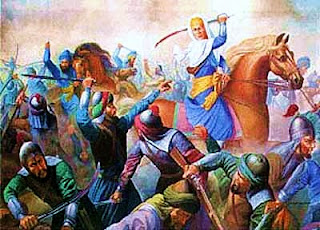During Christmas I was reflecting on how people celebrate this public holiday. Christmas is a time when those who follow JESUS CHRIST world dedicate to celebrating the BIRTH and LIFE of their Prophet during this cold and winter month. However, isn't it strange that birth of LIFE is celebrated with the DEATH of millions. You may be wondering what am I going on about. Nowadays eating Turkey is inescapable for celebrating Christmas. Millions of Turkeys and other birds are slaughtered for this festive season so that people can celebrate the LIFE of a holy man. What irony?
Gurbaani says:
ਜੀਅ ਬਧਹੁ ਸੁ ਧਰਮੁ ਕਰਿ ਥਾਪਹੁ ਅਧਰਮੁ ਕਹਹੁ ਕਤ ਭਾਈ ॥
jee-a baDhahu su Dharam kar thaapahu aDharam kahahu kat bhaa-ee.
You kill living beings, and call it Dharam (a religious action). Tell me, brother, what would you call A-Dharam (an athiestic action)?
ਆਪਸ ਕਉ ਮੁਨਿਵਰ ਕਰਿ ਥਾਪਹੁ ਕਾ ਕਉ ਕਹਹੁ ਕਸਾਈ ॥੨॥
aapas kau munivar kar thaapahu kaa ka-o kahuhu kasaa-ee. ||2||
You call yourself the most religious person; then who would you call a butcher? ||2||
(Ang 1103)
On Boxing Day I was at work. We were given a shortened lunch time to 30 minutes. The work people had organised lunches for the staff. They bought chicken, buns, cheese and Crisps for people to eat. In private the manager out of interest asked me whether I eat meat. I explained that I was a strict vegetarian, which includes not eating fish and eggs. Then he asked, "So what did you eat for lunch?" I told him that I eat at home or I bring a lunch box. I explained that today my mum made Rotian, which I had with Ahloo Mattar Paneer. In English it sounded WEIRD. I ended up saying, "I ate Chapattis with cheese and potatoe curry." Then he asked, "What did you eat for Christmas?" I ended up at the Gurdwara Sahib and had Langar because I didn't really fancy eating Roast Pork or Lamb. Vaheguru.
Translating some Daal Sabjeeaa is really difficult. I said to him, "I ate Red-Kidney Beans Curry (Raajmaa), a vegetable which I think is from the Cabbage family (Arbee), lentils (Daal)." When saying it in English it didn't sound as good as the Panjabi! He said "Sorry Manvir, eating lentils, beans and cheese every day, doesn't tickle my fancy." lol. (Not that I told him to eat Daal Sabjee).
Christmas is a time of remembering a birth that gave life to a community. Similarly, December marks a time of remembering life for Sikhs. However, for Sikhs the celebration of life in December is not birth but through DEATH.
ਸਲੋਕ ਮ: ੫ ॥
salok mehilaa 5.
Shalok, Dakhanay Fifth Mehl:
ਪਹਿਲਾ ਮਰਣੁ ਕਬੂਲਿ ਜੀਵਣ ਕੀ ਛਡਿ ਆਸ ॥
pehilaa maraN kabool jeevaN kee chhadd aas.
First, accept death, and give up any hope of life.
ਹੋਹੁ ਸਭਨਾ ਕੀ ਰੇਣੁਕਾ ਤਉ ਆਉ ਹਮਾਰੈ ਪਾਸਿ ॥੧॥
hohu sabhnaa kee rayNkaa tau aa-o hamaarai paas. ||1||
Become the dust of the feet of all, and then, you may come to me. ||1||
(Ang 1102)

The martyrdom of the Four Sahibzaadey (princes of Guru Gobind Singh Sahib jee) and martyrdom of Mata Gujar Kaur jee marks the celebration of eternal life glorified through death. They were SHAHEEDS (martyrs). Shaheed comes from the word SHAHAADAT, which literally means - "WITNESS TO THE TRUTH". These great souls overcame the illusion of the world and realised the precious value of Naam and Baani and therefore kept their undying faith in Guru Sahib and Sikhi.
For Sikhs martyrdom equals life of the community. Professor Mohan Singh asks in one of his poems:
“ਉਹ ਕਿਹੜਾ ਬੂਟਾ ਏ? ਹਰ ਥਾਂ ਜੋ ਪਲਦਾ ਏ, ਜਿੰਨਾ ਵੀ ਛਾਂਗ ਦਈਏ ਓਨਾ ਹੀ ਫਲਦਾ ਏ?”
"Which flower are they? Every place they blossom; even when chopped-down they grow more?"
The simple answer is the flower of Sikhi (ਸਿੱਖੀ ਦਾ ਬੂਟਾ). During the bloody period of the 18th century Sikh history, the Mughal forces brutally chopped the heads of Sikhs. The babies of mothers were hacked into pieces using their body parts as necklaces they were placed around the mothers' necks; however they did not falter or become weakened in their Sikhi spirit. Holding on to Naam, Baani and Ardaas they remained in Chardi Kalaa and undaunted by Death itself. The flower of Sikhi was chopped and split however through this the flower grew more and more. The Sikh mothers of the 18th century would sing in Chardi Kalaa:
“ਮੰਨੂ ਸਾਡੀ ਦਾਤਰੀ, ਅਸੀਂ ਮੰਨੂ ਦੇ ਸੋਏ, ਜਿਉਂ-ਜਿਉਂ ਮੰਨੂ ਵੱਢਦਾ ਅਸੀਂ ਦੂਣ-ਸਵਾਏ ਹੋਏ।”
(Meer) Mannu is the grass-cutter, and we Mannu's crop. As Mannu chops us down, so we multiply."
Sikh history is a witness to the fact that martyrdom is the life of a community. Therefore, Christmas season is a time when the Sikhs according to the Sikh calendar mark the martyrdom days of great Gursikhs who gave their lives for our today. They lived in dignity and died in honour.
ਕਬੀਰ ਜਿਸੁ ਮਰਨੇ ਤੇ ਜਗੁ ਡਰੈ ਮੇਰੇ ਮਨਿ ਆਨੰਦੁ ॥
kabeer jis marnay tay jag darai mayray man aanand.
(For the sake of the world people forsake religion to make wealth, riches, children and spouse, and upon these the person rests their happiness; for this reason attachment cannot break away. But,) O Kabeer! The death (in the form of freeing oneself from attachments), which the world is afraid of - that death fills my mind with bliss.
ਮਰਨੇ ਹੀ ਤੇ ਪਾਈਐ ਪੂਰਨੁ ਪਰਮਾਨੰਦੁ ॥੨੨॥
marnay hee tay paa-ee-ai pooran parmaanand. ||22||
It is only by this worldy death from attachment that one meets Vaheguru and experiences perfect and supreme bliss. ||22||
(Ang 1365)







































